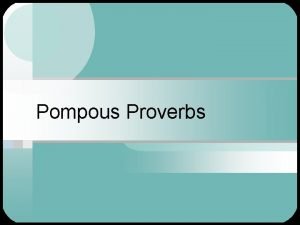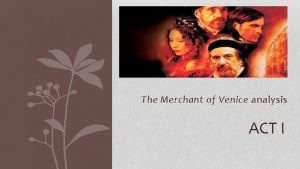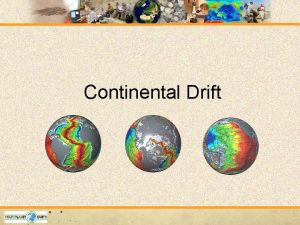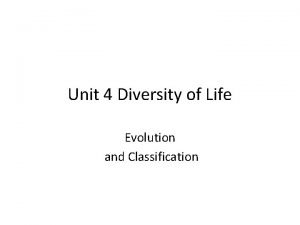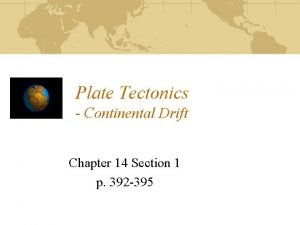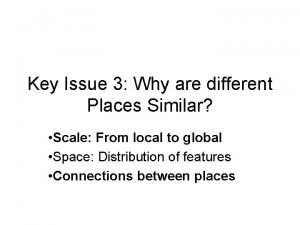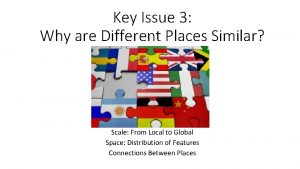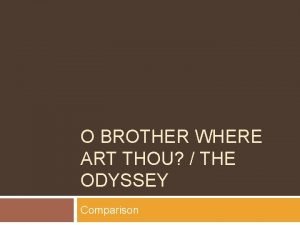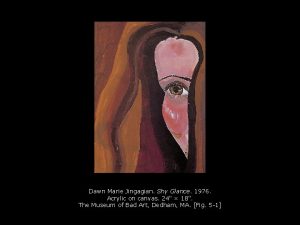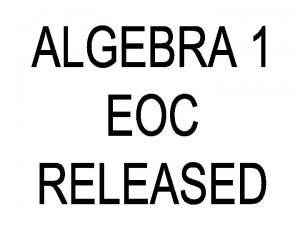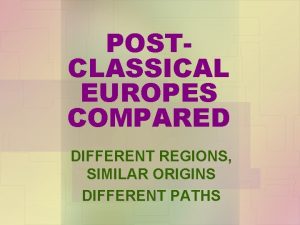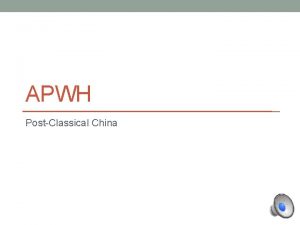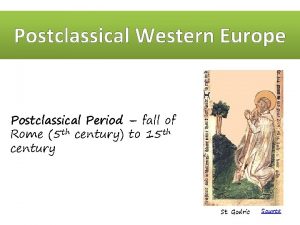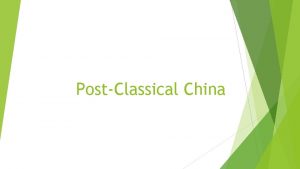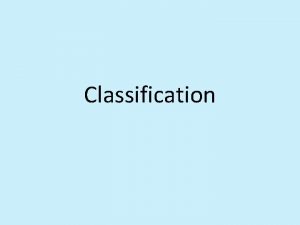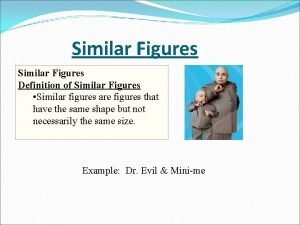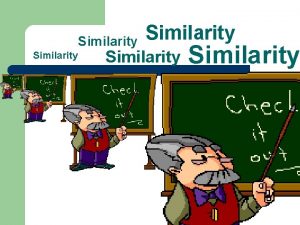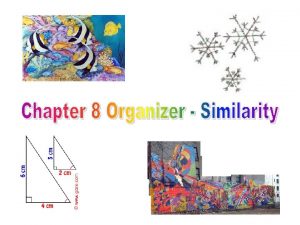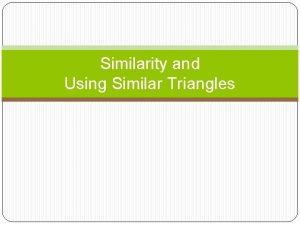POSTCLASSICAL EUROPES COMPARED DIFFERENT REGIONS SIMILAR ORIGINS DIFFERENT
















- Slides: 16

POSTCLASSICAL EUROPES COMPARED DIFFERENT REGIONS, SIMILAR ORIGINS DIFFERENT PATHS

GEOGRAPHIC DETERMINISM • • Division of the Empire into Eastern, Western Roman Empire was not arbitrary Western Mediterranean, c. 450 CE – – – • Small population Roman ruling urban elite • • • Latin was the language of government Italy and parts of Spain were Latin, cities were Roman Christianity was an urban phenomenon Non-Roman countryside • • Many vernaculars and few spoke Latin Countryside retained many pre-Roman traditions Intellectual tradition often copied older works rather than originated new ideas Most of population was not Christian Large commercial, latifundia tradition • • Little industry, irregular commerce Negative balance of trade: bought more than they sold – net loss of gold Eastern Mediterranean, c. 450 CE – – – Large population Greeks formed the ruling urban elite • • Greek spoke around Aegean, Eastern cities Cities were largely Hellenized Non-Greek countryside • • Many vernaculars and few spoke Greek Countryside retained many pre-Greek traditions Strong intellectual tradition among Greeks, non-Greeks Both cities and countryside were Christian BUT • • Cities practiced many heterodox versions of Christianity Countryside practiced Christianity mixed with many pre-Christian traditions Many of the early heresies originated in the East Four of five patriarchates in East (Constantinople, Alexandria, Jerusalem, Antioch) Commercial, small farms mixed tradition • • With vibrant industry, strong commerce Positive balance of trade – net gain of gold

FOUR CLASSICAL TRADITIONS • Caesar – Greco-Roman Traditions – Hellenistic Cosmopolitan Traditions • • Greek language and literature Greek philosophical traditions Greek art and architecture Strong mercantile tradition – Roman Legal Traditions • • • Rule of Law and Citizenship: All Equal Before Law Judicial Review (to a degree) Balanced Government (to a degree) Elite landed classes Christ – The Judeo-Christian Tradition – Jewish Traditions • Denied, ignored and downplayed by Christianity • Early Church was Jewish as were Jesus, Apostles, early saints – Christianity • • Christianity attracted lower classes, slaves for centuries Later began to attract ruling elite 315 – 380 CE: Christianity legalized, later becomes only state religion Romanization of the Church Structure – Church increasingly adopted Roman imperial, legal terms – Church hierarchy modeled after Roman governmental hierarchy – Churches modeled after basilicas and Roman legal traditions

LATE CLASSICAL INTERACTIONS • Western Roman Empire, c. 400 CE – Others • • • No major states, civilizations on the borders No major trading states, partners and little commercial interaction Peoples were semi-civilized and often hostile to Rome – Rivals • • Traditional Enemy: Germanic Tribes Short Term Enemy: The Huns – Western Roman Army • • • Largely mercenary as Romans would no longer serve in military Feudal relationship between empire, Germans settled as mercenaries Whole provinces, regions turned over to German settlers and not subject to Rome Local elites provided for local defense Eastern Roman Empire, c. 400 CE – Others • • Strong states in Persia, Armenia, Ethiopia, Kush-Meroe Strong trading contacts with Southwest Asia, East Africa, and India – Rivals • • Traditional Enemy: Sassanid Persia Short Term Enemy: Germans and Huns – Eastern Roman Army • • Based on heavy, armored cavalry supported by infantry, siege troops Strong naval components and very sturdy fortified cities, walls Armies were largely paid professionals led by professionals Defense was not left to locals but controlled by Emperor, imperial bureacracy

LATE CLASSICAL INTERACTIONS • Germans and Huns • Eastern Roman Empire • – Invaded both East, West Roman Empire – Did not have the same effect on both empires – – Goths destroyed one Eastern Roman army but empire recovered Eastern Empire not bothered by the Huns: too many walled cities Eastern Emperor bribed Goths to go West Eastern Roman Empire survived invasions of Germans, Huns Western Roman Empire – – Germans already in empire c. 400 CE as settlers Huns appeared and Germans sought refuge Germans, Romans team up to defeat Huns After Huns, German rulers decided to “keep” Roman Empire • Vandals settled in Africa • Visigoths, Suevi, Alani settle in Iberia • Franks, Burgundians settle in France, Belgium • Ostrogoths settle in Italy • Angles, Saxons, Jutes settle in England – Rome sacked twice, last emperor deposed in 476 CE – Later Germanic Invasions • Lombards move into Italy, Croatia: disrupt Byzantines in Italy • Franks expand into Germany, Netherlands and later into Italy

• EARLY POST-CLASSICAL INTERACTIONS Western Europe – – – • 6 th Century saw the rise of the Frankish Kingdom (Empire) • • • Franks gradually brought France, Belgium, Germany under their control Later invaded Italy after Pope asked Franks for help Frankish army was very powerful and well-organized Visigoths unite Spain: survive Byzantine invasion but not Arab invasion Byzantines invade Western Mediterranean • • Destroy Ostrogoth, Vandal kingdoms Halted by more numerous Germans as wars bankrupted Byzantines Eastern Europe – – The Mediterranean • • The Slavs and Asian Pastoral Nomads • • – – Justinian reconquered Italy, North Africa, Southern Spain Came close to reunifying Roman Empire but bankrupted Byzantines The Slavs beginning 600 – 750 CE – After Germans evacuate Eastern Europe, Slavs push out of Russia into region – Slavs push into Eastern Roman Empire, Balkans: nearly destroy Empire – Later joined by Bulgars (Turks) who settle in Thrace, adopt Slavic traditions Slavic and Byzantine Interaction – Slavs overran much of European Byzantine Empire – Greeks begin process of conversion of Slavs to Christianity Many Asian Pastoral Nomads invade Eastern Roman Empire • Could never capture cities which were heavily fortified • Could rarely control seas The Persians and Arabs • • Byzantines battled Persians to a standstill but could never win Arabs came in and destroyed Persians, conquered Southern Mediterranean – Arabs overran North Africa, Holy Land, Syria – Seize Cyprus, Sicily, Crete, Balerics, Sardinia and threaten Constantinople – Byzantine fortified cities defied Arabs and protected interior lands from conquest

LATER POST-CLASSICAL INTERACTIONS • Western Europe – – Spain: After 711 Muslims invade, conquer Spain beginning Reconquista of the Christians Frankish Kingdom from 5 th c. CE through 9 th Frankish Empire of 9 th c. CE • • – • 800: Franks create Frankish Empire 850: Frankish Empire breaks up – Eastern Frankish Kingdom » Controlled Germany, Austria, Czech Republic » Eventually became Holy Roman Empire and pushed boundaries into Poland, north to Baltic – Western Frankish Kingdom » Controlled Gaul, Aquitaine » Eventually became Kingdom of France – Kingdom of Lothair later partitioned by two other states » Lands between Eastern, Western Frankish states » Ruled Netherlands, Belgium, Lorraine, Alsace, Burgundy, Italy 9 th Century: Age of the Vikings (Denmark, Norway) in the West After 10 th Century: feudal conflicts give way to increased trade Crusades • • • First Crusade was not against Turks in Holy Land but Muslims in Spain Crusades in Spain, Baltic Regions, Holy Lands and later against heretics Crusades also expanded trade contacts in Western Mediterranean Eastern Europe – Byzantines • • • – There were always strong commercial contacts between Byzantines and neighbors 6 th through 10 th Century – Slavs establish states in Balkan – Byzantines eventually overran them all after converting them to Christianity After 10 th century: decline – Initiated by invasion of the Seljuk Turks, later sack of Constantinople by 4 th Crusade – Final destruction in 1453 by Ottoman Turks Russia • • 9 th Century: Rise of Kievan Rus state in Russia Founded by Swedish Vikings who had raided, traded in Russia, Black Sea Strong commercial contacts with Khazars, Arabs, Byzantines, German Hansa of Northern Europe Russia done in by Mongols in 13 th century

MILITARIES COMPARED • Frankish Empire, Holy Roman Empire AND Kievan Rus – Feudal Military System • • Dominated by aristocratic warriors who had to furnish everything No national forces – only local feudal forces: state furnished nothing Local lord receives land from king, promises to defend area Local lord provides small number of troops to police area 40 days of year king has use of knights, nobles for his wars Small armies mostly knights, some foot soldiers Small fortified castles, towns – Holy Roman Empire followed same tradition – Kievan Rus were outsiders (Vikings) who rarely used local Slavs • Byzantine Military – Professional Military Forces: Think Old Roman Military prior to 200 CE • • • Soldiers were paid for service, trained by state and often served 25 years Officers were aristocrats but could also be commoners, who could become nobles Country divided into defensive zones run by military Military answers directly to emperor but led in battle by professional generals State paid for construction of forts, fleets, arms, siege equipment, supplies, etc. – Local militias • • Each province also maintained a local guard of local people Most males could serve – Elite Mercenary Units maintained by Emperor: Varangian Guard

COMMERCIAL INTERACTIONS • Byzantines – – – • Kievan Rus – – – • A strong mercantile tradition Extensive contacts throughout region Traded as far as India, China, East Africa; traded with Muslims heavily Strong gold currency was a medium for many Industry known for production of luxuries Influential merchant class but no political influence State began as a result of raiding and trading Trade network of Swedes ran from Baltic to Black to Caspian Many of their settlements were centers of trade for steppe Many contacts with foreigners Traded in slaves (from Slav), honey, horses, wood, amber, furs France, Germany, Italy – c. 500 • • • Trade was almost no existent due to wars No strong merchant class in France, Germany; small one in Italy Society was self-sufficient (feudal manorialism) and trade not important – c. 1000 • • • Trade revived in parts of region but not all – true of Italy, Netherlands Revival of trade due to rise of cities Society still did not overly trust, need merchants except for luxuries

STATE STRUCTURES: EAST • Byzantine Empire – – • Centralized Empire • All power resides with the Emperor • Emperor rules through bureaucracy • Bureaucracy is trained and not aristocratic • Emperor appoints all men to positions • Aristocrats excluded often from influence Autocratic • Emperor is absolute • No opposition is allowed if he is really strong – removes enemies Caesro-Papism • Divine Right Monarchy – emperor is God’s anointed rep on earth • Emperor is the head of the Church • Appoints Patriarch, bishops • Oversees church but does not run it • Often has final say so in church theological disputes Only after 1250 did Byzantines become feudal and then because they could not afford money Kievan Rus – Decentralized Monarchy • Prince not powerful enough to enforce uniformity • State was very large and distance made centralization difficult • Powerful nobles often ruled own estates and principalities without his input • Nobles were very combative and tended not to like someone ruling them – Prince did not appoint Church leaders, they were elected by clergy • • Clergy not independent of state Prince had more influence over church than did West Europeans but less than Byzantines

STATE STRUCTURES: WEST • Early Germanic States – – • Early Frankish State: Merovingian Dynasty – – • Mayor of Palace Charles Martel defeats Muslims at Tours Pippin overthrew Merovingian kings with papal blessing Charlemagne was his son; crowned emperor by pope to oppose Byzantine emperor Church and state cooperated – both resented the other but needed each other Charlemagne tried to centralize but produced feudal state – – – • Kings wanted to centralize but often not strong enough Nobles called counts challenged king: Mayor of Palace held power Clovis converted to Catholicism in order to get papal support, influence King traded land for troops – nobles got land, king got their military service Carolingian Dynasty or Empire – – • Very similar to Kievan Rus King had power but only if he was strong, could enforce his rule Nobles owed allegiance, service but resisted too much royal power Most people were free and king had to convince them of his rights Nobles ruled their lands often independently of emperor They owed emperor service, support, aides but only to a certain level Charlemagne tried to centralize but nobles resisted Later kingdoms in Germany, France, Italy – – Charlemagne’s state was partitioned between his descendants Germany, France created a system similar to Charlemagne Italy broke up into city states, small princely states with republican aristocratic governments Feudalism strong in Germany, France but never in Italy

CHRISTIANITY • UNTIL 1054 – Same religion • You can only speak of Christian • All state churches cooperated • All recognized pope – As their spiritual leader – But he was not supreme nor recognized as such – Different rites • • A rite is the way a people worship Includes language of service and traditions The Catholic Church recognizes today 22 different rites as Catholic One is the Byzantine tradition • Until 1054 – – – Western Europe, Byzantines, Kievan Rus SAME religion In all, the Church was not predominant State tended to be supreme more or less in all BUT…. .

CHANGES • Latin Christianity to 1000 CE – – – – – Priests not encouraged to marry Communion with unleavened bread Spoke, used Latin in services Tended to follow Bishop of Rome (Pope) but this was not always true Pope elected by Roman clergy Senior church positions appointed by secular rulers subject to pope ok German kings did not recognize pope as supreme NO separation of Church and State; cooperation by equals Pope increasingly trying to enforce his rule, supremacy in West • Eastern Christianity – – – – Priests could be married at time of ordination but not marry after Bishops could not be married Communion with leavened bread (azimes) Liturgy in the local vernacular (Greek, Slavonic, Coptic, Syriac) Four Patriarchs: Constantinople, Alexandria, Antioch, Jerusalem All decisions of church made jointly by bishops in council! Churches subject to extensive control, oversight by secular authorities No separation of church and state

THE SCHISM • Purported Controversies! – – – • Azimes vs. Unleavened bread • East use leavened bread in communion • East use unleavened bread in communion • Tradition says communion came about at Passover – unleavened Filoque: From the Father AND THE SON • Nicaean Creed agreed to in two different church councils • Without consulting council, Pope changes it • Franks pressured pope to add three words “and the son” • Eastern Churches said pope would not do that without council Married Priests • Christ’s apostles were married – so was Paul – so were early popes • West ended married priesthood because Church losing property – East said not tradition Latin vs. Vernacular • East always used local language to preach, pray • West insisted on uniformity using Latin – as East pointed out, Holy Spirit multi-lingual Icons • Eastern Emperors decided that icons were sacrilegious and barred them from service • Eastern, Western Church leaders opposed iconoclasm but emperor was more powerful • Icons eventually restored under influence of Byzantine empresses! Both churches use Church Orders and Active Monasteries vs. Isolated Monasteries and No Orders Real Controversy – – Pope did not like to take orders from kings or EMPEROR IN CONSTANTINOPLE Pope had created Charlemagne an emperor to use him to balance Byzantine Emperor – east upset Emperor, Patriarchs did not want to take orders from Pope was influential and a secular prince: Eastern Churches had no political voice

1054 • Great Schism – Now use terms • Roman Catholics (universal) • Orthodox (correct) – put a nationality in front to indicate language used – Most religious aspects of churches identical – Not so much religious as political deepened by war • West – – Once Schism occurred, Western lords attacked Byzantines Used their influence to undermine East at all occasions Declared east to be heretics 4 th Crusade: sacked Constantinople, raped Byzantines • East – Did not trust West: tended to cooperate better with Muslims – Removed all Papal office holders at order of Eastern rulers – Changed law codes to make Catholicism illegal

CHANGES AFTER 1054 • Roman Catholicism – Pope increasingly powerful • • Subjects all bishops to his rule Insists on uniformity and tries to enforce it where he can Becomes a secular prince in all ways Used Church to enforce his political will – Constantly battled princes for right to invest clergy • Princes wanted to give them secular authority • Popes felt they alone had right to do both • Led to wars and princes eventually one this – Led to Babylonian Captivity, 2 nd Schism, Reformation • Orthodox Christianity – – Secular rulers increasingly dominate church Often interfered in church affairs including theology Church increasingly identified as a form of nationalism Any attempt at internationalism discouraged
 Similar
Similar Similar sire similar scion
Similar sire similar scion Similar disuelve a similar
Similar disuelve a similar Unidad de medida de solubilidad
Unidad de medida de solubilidad Allusions in merchant of venice act 1
Allusions in merchant of venice act 1 Similar fossils found on different continents
Similar fossils found on different continents Binomial nomenclature
Binomial nomenclature Similar fossils found on different continents
Similar fossils found on different continents Key issue 3 why are different places similar
Key issue 3 why are different places similar Why are different places similar geography
Why are different places similar geography Oh brother where art thou odyssey
Oh brother where art thou odyssey Dawn marie jingagian
Dawn marie jingagian Taj mahal poem by rabindranath tagore
Taj mahal poem by rabindranath tagore Dorsal view of sheep brain
Dorsal view of sheep brain Texas compared to alaska
Texas compared to alaska Dennis compared the y intercept of the graph
Dennis compared the y intercept of the graph Earth vs mars size
Earth vs mars size

